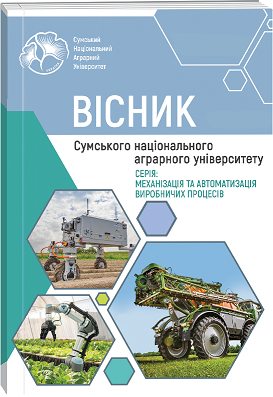УДОСКОНАЛЕННЯ ПИЛОЗБІРНИКІВ ДЛЯ ВПРОВАДЖЕННЯ У ХАРЧОВІЙ ПРОМИСЛОВОСТІ
Анотація
У даній роботі представлено дослідження процесів, що відбуваються в апаратах із зустрічними закрученими потоками, та запропоновано математичну модель для розрахунку часткової та загальної ефективності пристроїв. На експериментальному стенді було досліджено типову та удосконалену конструкції апарату із зустрічними закрученими потоками. Для визначення загальної ефективності зразки досліджували на дисперсний склад за допомогою скануючого електронного мікроскопа з низьковакуумною камерою СЕМ–106 І та стрічкою з напиленим сріблом у вакуумному універсальному посту ВУП–5М. Недоліком типової конструкції вдосконаленого апарату із зустрічними закрученими потоками (АЗЗП) є зменшений обертальний рух первинного потоку, що уповільнює процес сепарації та призводить до зниження фракційної ефективності очищення середніх і дрібних фракцій запиленого продукту з повітря. Гальмуючий ефект обумовлений малим вхідним імпульсом руху в первинному потоці порівняно з імпульсом руху у вторинному потоці. Таким чином, у типовій конструкції АЗЗП нижній вихор вдвічі менший за верхній, а імпульс потоку дорівнює швидкості повітряного потоку. Одним із способів збільшення обертального руху первинного потоку може бути збільшення вдвічі M1 , відповідно до закону збереження імпульсу, за рахунок геометричних змін нижньої циліндричної частини апарату. Тобто, необхідно збільшити діаметр нижньої частини АЗЗП, щоб збільшити імпульс у первинному потоці осьового завихрювача. У цьому випадку співвідношення витрат повітря та імпульсів буде зрівноважено і ефект гальмування буде усунений. Завдяки розробленій математичній моделі видно, що зі збільшенням імпульсу руху в первинному потоці осьового завихрювача підвищується ефективність уловлювання дрібних частинок пилоподібного продукту у зовнішньому та внутрішньому шарах розділової камери вдосконаленого АЗЗП. Це покращує загальну продуктивність. Після підготовки зразків до аналізу та дослідження їх на растровому мікроскопі отримали зображення дисперсного складу продукту, на якому розраховували кількість частинок певного діаметра, а потім розраховували їх у відсотках до загальної кількості частинок в одному зразку, таким чином отримали ефективність для кожної фракції частинок. А саме, найменша частка захоплених частинок склала 1,99 мкм удосконаленого АЗЗП, типової конструкції – 2,55 мкм. Отже, завдяки розробленій математичній моделі імпульсу руху для первинного завихрювача була створена вдосконалена конструкція АЗЗП.
Посилання
2. Azarov, V.N., Dobrinskiy, D., Lupinogin, V. & Sakharova, A. (2019). Determination methodology of the subsidence speed of small–dispersed particles of different ranges of storage facilities by visual recording. E3S Web of Conferences (Vol.126, № 1, p. 00072). doi.org/10.1051/e3sconf/201912600072
3. Azarov, V.N., Sergina, N.M., Majd Ostali, Sakharova, A.A. & Kopeikina, A.A. (2019). On some features of the layout of dust cleaning systems with vortex inertial devices with counter swirling flows. Engineering Bulletin of the Don, 1 (6).
4. Azarov, V.N., Kuzmichev, A.A., Nikolenko, D.A., Vasilev, A.N. & Kozlovtseva, E.Y. (2020). Issledovanie dispersnogo sostava pyli gorodskoj sredy [The research of dust dispersed composition of urban environment]. Ezhemesjachnyj zhurnal po stroitel’stvu i arhitekture, 15(3), 432–442 (in Russian). DOI:10.22227/1997–0935.2020.3.432–442
5. Azarov, V.N., Barikaeva, N. & Solovyeva, T. (2016). Monitoring of Fine Particulate Air Pollution as a Factor in Urban Planning Decisions. Procedia Engineering, 150, 2001–2007. DOI: 10.1016/j.proeng.2016.07.279
6. Azarov, A.V., Zhukova, N.S. & Antonov F.G. (2017). Water–spray systems reducing negative effects of fine–dispersion dust at operator’s workplaces of machine–building industries. International Conference on Industrial Engineering, Procedia Engineering (Vol. 206, pp. 1407–1414). DOI: 10.1016/j.proeng.2017.10.653
7. Bakaeva, N.V., & Chernyaeva, I.V. (2017). Criterion for estimation of ecological safety of objects of urban transport construction. In IOP Conference Series: Materials Science and Engineering (Vol. 262, No. 1, p. 012192). IOP Publishing. DOI:10.1088/1757–899X/262/1/012192
8. Besarion Meskhi, Evtushenko, А., Azarov, V. & Zhukova, N. (2021). Comprehensive assessment of the dust environment at the construction industry enterprises. E3S Web of Conferences (Vol. 281, № 5, p. 09024) doi.org/10.1051/e3sconf/202128109024
9. Bogomolov, A., Sergina, N. & Kondratenko, T. (2016). On Inertial Systems, Dust Cleaning and Dust Removal Equipment, and Work Areas in the Production of Aerated Concrete from the Hopper Suction Apparatus CSF. Procedia Engineering, 150, 2036–2041. DOI: 10.1016/j.proeng.2016.07.290.
10. Bogomolov, A. N., Zhukova, N. S., Azarov, D. V., & Khegai, D. S. (2016). Ocenka pylevogo faktora v vozduhe rabochej zony na predprijatijah po proizvodstvu mela [Assessment of dust factor in air of the working zone at the enterprises of chalk production]. Vestnik Volgogradskogo gosudarstvennogo arhitekturno-stroitel’nogo universiteta. Serija: Grazhdanskoe stroitel’stvo i arhitektura, 43(62), 175–188 (in Russian).
11. Evtushenko, A.I., Sakharova, A.A., Kharlamov, V.O. & Azarov, V.N. (2020). The study of the silica clay dust elemental composition in building materials’ production. IOP Conference Series Materials Science and Engineering (Vol. 913, № 3, pp.032047). DOI: 10.1088/1757–899X/913/3/032047
12. Kuzmichev, A.A. & Loboyko, V.F. (2016). Impact of the Polluted Air on the Appearance of Buildings and Architectural Monuments in the Area of Town Planning. Procedia Engineering, 150, 2095–2101. DOI: 10.1016/j.proeng.2016.07.244
13. Kondratenko, T.O. (2021). Solutions to reduce dust emissions mass into urban air in aerated concrete production. E3S Web of Conferences (Vol.281, p. 09012). https://doi.org/10.1051/e3sconf/202128109012
14. Kondratenko, T.O., Danilova–Volkovskaya, G.M., Fursov, V.A. & Kobalia, T.L. (2019). The basic properties study of the dust particles entering the localization system and emissions cleaning in the aerated concrete production and building gas concrete blocks. IOP Conf. Series: Materials Science and Engineering (Vol. 698, p. 022075). IOP Publishing. doi:10.1088/1757–899X/698/2/022075
15. Kondratenko, T.O. (2020). Experimental studies to develop the measures for reducing dust emissions mass into the atmosphere from the sources of the aerated concrete structures shop. Conf. Series: Materials Science and Engineering (Vol.913, p. 052047). IOP Publishing. doi: 10.1088/1757–899X/913/5/052047
16. Kondratenko, T.O. & Lapina, A.P. (2020). Assessment of the concentration and properties of dust in emissions into atmospheric air from the sources of the workshop for the aerated concrete structures production. Conf. Series: Materials Science and Engineering (Vol.1083, pp. 01208–12020). IOP Publishing. doi: 10.1088/1757–899X/1083/1/012081
17. Kalyuzhina, E.A., Kireyeva, A.I., Marinin, N.A., Gladkov, E.V., & Mikhailovskaya Yu.S. (2013). Ob approksimacii integral’nyh funkcij dispersnogo sostava pyli v vozdushnoj srede. [About approximation of integrated functions of disperse structure of a dust in the air environment]. Al’ternativnaja jenergetika i jekologija, 14(136), 52–56 (in Russian).
18. Kuzmichev, A.A., Azarov, V.N., & Kuzmichev, A.V. (2017). The research of contamination regularities of historical buildings and architectural monuments by methods of computer modeling. In MATEC Web of Conferences (Vol. 129, p. 05002). EDP Sciences. https://doi.org/10.1051/matecconf/201712905002
19. Koshkarev, S.A., Stefanenko, I.V., & Koshkarev, K.S. (2019). Complex dispersed analysis of particles applying in output hydrodynamic criteria decreasing dust leakage’throw collectors of aspiration in construction industry. In IOP Conference Series: Materials Science and Engineering (Vol. 687, No. 6, p. 066074). IOP Publishing.
20. Klimenti, N.Yu., Khorzova, L.I., Azarov, D.V. & Vlasova O.S. (2019). Experimental investigation of aerodynamic properties of colour pigment for calcium silicate bricks. IOP Conference Series: Earth and Environmental Science (Vol. 315, № 6, p. 062007). IOP Publishing.
21. Protodiakonov, Y.O. & Chesnokov, Yu.G. (1987). Gidromehanicheskie osnovy himiko-tehnologicheskih processov [Hydromechanical foundations of chemical technology processes]. Uchebnik dlja vuzov. L.: Himija, 360 p. (in Russian).
22. Piralishvili, Sh.A. & Kudryavtsev, V.M. (1992). Issledovanie haraktera raspredelenija osrednennyh parametrov zakruchennogo potoka po obemu kamery vihretrubnogo jenergoseparatora s dopolnitel’nym potokom [Investigation of the nature of the distribution of the averaged parameters of the swirling flow over the chamber volume of the vortex tube energy separator with an additional flow]. IFZh, 62(4), 534–538 (in Russian).
23. Sergina, N.M., Sakharova, A.A., Azarov, V.N., Azarov, D.V. & Nikolenko, M.A. (2019). Dust emissions’ reduction into the atmosphere by environmental–engineering systems of smallsize devices with counter–swirling flows (CSF). Web of Conferences (Vol.138, p. 01037). URL: https://doi.org/10.1051/e3sconf/201913801037
24. Sergina, N.M., Kondratenko, T.O., Nikolenko, M.A. & Pushenko, S.L. (2017). Principles of layout and assessment of the systems effectiveness to protect against dust pollution of air in the working area and atmospheric air. International Scientific Conference Energy Management of Municipal Transportation Facilities and Transport (Vol. 692, pp. 710–719). DOI:10.1007/978-3-319-70987-1_75
25. Savchenko–Pererva, M.Yu, Potapov, V.O., Radchuk, O.V. & Rozhkova, L.G. (2016). Improving the efficiency of vortex dust catchers for food industry. Industrial technology and engineering, Kazakhstan, 3(20), 62–69.
26. Savchenko–Pererva, M.Yu. & Yakuba, O.R. (2015). Improving the efficiency of counter–swirling devices for the food industry. Eastern European Journal of Advanced Technology, 3/10 (75), 43–48. DOI: 10.15587/1729–4061.2015.43785
27. Sabadash, S.M., Yakuba, O.R. & Kazakov, D.D. (2015). Development of the post–alcohol stillage drying process on inert bodies and output of criterion dependence. Eastern European Journal of Advanced Technologies, 1/6(73), 65–70. DOI:10.15587/1729–4061.2015.38056
28. Vasiliev, A., Stefanenko, I.V., Azarov, V.N. & Nikolenko, D.V. (2019). The study of the aerodynamic characteristics of dust particles in the air of roadside areas. E3S Web of Conferences (Vol.126, 00071). Publisher: EDP Sciences. doi.org/10.1051/e3sconf/201912600071.
29. Zhukova, N.S., Ostaali, M., & Khegay, D.S. (2016). About fractional breakthrough dust for emissions to atmosphere after a cyclone. Biosphere compatibility: people, regions, technologies, 1(13), 68–76.
30. Zhukova, N.S., Dobrinskij, D.R., & Azarov, A.V. (2017). Reduction of pollutant concentrations under adverse weather conditions with optical dynamic measurement systems. In 2017 International Conference on Industrial Engineering, Applications and Manufacturing (ICIEAM) (pp. 1–3). IEEE. DOI: 10.1109/ICIEAM.2017.8076488

 ISSN
ISSN  ISSN
ISSN 



